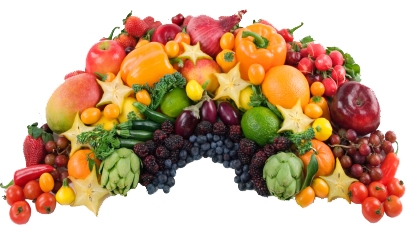Why You Should “Eat The Rainbow”!
When I was growing up, I remember my Mom teaching me that it was important to “eat the rainbow”. At the time, I thought it had more to do with the presentation of a meal, but as I have studied more about nutrition, I realize that “eating the rainbow” had more to do with eating a variety of nutrients that have a powerful impact on our overall health, and less to do with Skittles® candies.

How To Eat The Rainbow
“Eating the Rainbow” refers to the practice of eating fruits and vegetables of all the different colors to provide your body with a variety of nutrients. Produce with similar colors tend to have many of the same nutrients and health benefits, which makes it important to eat from all of the different colors of “the rainbow”!
I have listed the health benefits commonly associated with each of the colors and have provided some examples of produce within that color group.
Red
Fruits and Vegetables that are red will contain either lycopene, which fights against cancer or it will contain anthocyanins, which is a powerful antioxidant that protects cells from damaging and has been shown to have amazing benefits for the heart.
Examples: Beets, Watermelon, Red Peppers, Strawberries, Red cabbage, Tomatoes, Red Apples, Radishes, Red Grapes, Red Potatoes, Pomegranates, Raspberries, Cranberries, Pink Grapefruit, and Cherries.
Orange
Fruits and Vegetables that are orange contain carotenoids, which has been reported to reduce the risk of cancer, heart disease and can even help improve immune system function. Orange citrus fruits, like oranges, may not have significant amounts of carotenoids, but they have high amounts of B vitamins, vitamin C, and folate – which has been shown to help reduce the risk of birth defects.
Examples: Pumpkin, Apricots, Carrots, Oranges, Sweet Potatoes, Peaches, Mangoes, Butternut Squash, Papayas, Cantaloupe, and Nectarines.
Yellow
Fruits and Vegetables that are yellow contain zeaxanthin, which is a bioflavonoid that provides anti-inflammatory and antioxidant benefits to prevent free radical damage to the eye (specifically the retina and the lens of the eyes) and works with lutein for healthy eye development.
Examples: Sweet Corn, Yellow Peppers, Pears, Yellow Tomatoes, Pineapple, Yellow Apples, Lemons, and Yellow Squash.
Green
Fruits and Vegetables that are green may contain chlorophyll, which may help prevent cancer, and lutein, which helps with eye health and development. Many green produce is also high in folate and other essential nutrients.
Examples: Spinach, Honeydew Melon, Green pepper, Limes, Green apples, Cucumbers, Green Onions, Green Grapes, Asparagus, Green Cabbage, Avocados, Brussels Sprouts, Lettuce, Peas, Broccoli, and Green Beans.
Blue/Purple
Fruits and Vegetables that are blue or purple contain anthocyanins, which is a powerful antioxidant that protects cells from damage, may reduce the risk of cancer, stroke, and heart disease. Blueberries, for example, are linked to healthy aging and improved memory function.
Examples: Blueberries, Plums/Prunes, Blackberries, Egg Plant, Purple Grapes/Raisins, Juneberries, and Figs.
White
Fruits and Vegetables that are white contain anthoxanthins, which have been shown to help lower cholesterol, blood pressure, and may reduce the risk of heart disease and some cancers.
Examples: Cauliflower, Bananas, Onions, Potatoes, Mushrooms, Garlic, Turnips, Ginger, and Jicama.
Feel free to follow us, however you like: Google+, Facebook, Twitter, Pinterest
